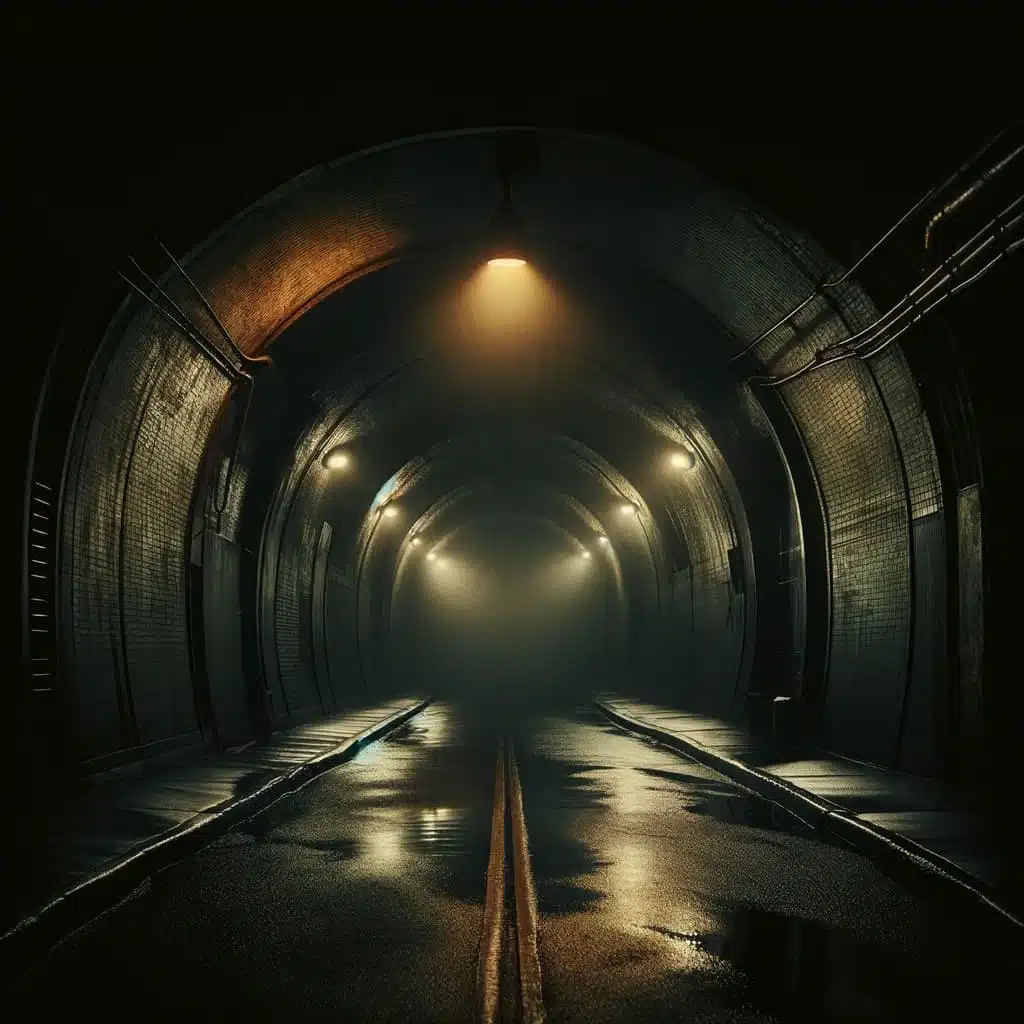“The Tunnel” (El túnel) is a novel by Argentine author Ernesto Sabato that tells the story of Juan Pablo Castel, a lonely and anguished painter. The plot centers on Castel’s obsession with María Iribarne, a woman he perceives as the only person capable of understanding his art and world vision. Loneliness, isolation, and existential despair are explored as the story unfolds. The novel, set in Buenos Aires in the 1940s, offers a deep introspection into the mind of its protagonist, immersing the reader in a world where obsession and the search for connection play a crucial role. “The Tunnel” is an introspective work that questions the nature of reality, perception, and human nature.
Tabla de contenidos

Summary of “The Tunnel” by Ernesto Sabato
“The Tunnel” (El túnel), a novel by Argentine writer Ernesto Sabato, published in 1948, is a profound psychological study of obsession, isolation, and madness. It is narrated through the voice of its protagonist, Juan Pablo Castel; it is a somber and existentialist tale that explores the darkest abysses of the human soul.
The story begins with a surprising confession: Castel, an Argentine painter, admits to having murdered María Iribarne, the only woman who, according to him, could understand his art and with whom he shared a stormy relationship. This murder is the tragic climax of an obsession that unfolds throughout the novel.
Castel’s first encounter with Maria occurs at an exhibition of her paintings, where he notices that she is particularly attracted to a tiny detail in one of her works: a window showing a solitary woman looking out to sea. This detail goes unnoticed by everyone else, leading Castel to believe that Maria has a special connection to her inner world.
Obsessed with this idea, Castel begins a frantic search for Maria, which leads him to follow her and engage in an awkward and forced dialogue when he finally finds her. Despite being married, Maria becomes involved in a game of seduction with Castel, marked by ambiguity and deception.
The relationship between the two becomes increasingly complex and dark. Castel, unable to bear the uncertainty and jealousy, plunges into an abyss of paranoia and distrust. He is convinced that Maria is having a secret affair with her cousin Hunter, which leads him into a state of constant suspicion and delirium.
The novel’s climax is reached when Castel, in a fit of madness, murders Maria. This act is both a release from his obsession and the culmination of his isolation from the outside world. The novel closes with Castel in prison, reflecting on his actions and the incomprehension of the world around him.
Sabato’s narrative is introspective and detailed, allowing the reader to enter Castel’s tortured mind. The prose is fluid but charged with tension, reflecting the protagonist’s inner turmoil. The work studies loneliness, the desire for connection and the inability to achieve it, and themes throughout the narrative.
“The Tunnel” is not only a story about love and obsession but also an exploration of existentialism and the human condition. Sabato uses the plot to delve into the depths of the human psyche, showing how loneliness and isolation can lead to madness and despair. The work reflects the individual’s struggle to find meaning in a seemingly absurd and indifferent world.
“The Tunnel” is a work that not only tells the story of a crime of passion but also delves into the complexities of the human mind, exploring themes such as alienation, obsession, and madness. Its unique narrative style and its focus on the psychology of the characters make this novel an essential piece of 20th-century literature.
Main characters of “The Tunnel”.
Juan Pablo Castel: The protagonist and narrator of the story, a painter tortured by his isolation and existential despair. Castel is a deeply conflicted and paranoid character whose obsession with María Iribarne is the novel’s central focus. Throughout the novel, we see his descent into madness, driven by jealousy, insecurities, and a desperate longing for a connection he believes he has found in Maria. His evolution is a progressive degradation from introspective loneliness to total and destructive isolation.
María Iribarne: The enigmatic woman who becomes the object of Castel’s obsession. Maria is a complex character, presented through Castel’s skewed perception, making her partly mysterious and tragic. Throughout the novel, she appears sympathetic and level-headed, albeit with her own emotional and marital complexities. The relationship between Maria and Castel is a dance of rapprochement and estrangement, where she seems both victim and accomplice to his obsession.
Allende: A friend and colleague of Castel’s who represents one of Castel’s few connections to the outside world. Through Allende, a visually impaired man, we see a contrast between Castel’s relative normalcy and his distorted perception of reality. Allende is a secondary character, but his interaction with Castel provides crucial insight into how others perceive the protagonist and how his behavior is increasingly erratic and disconcerting.
Hunter: Maria’s cousin is a character on whom Castel projects much of his paranoia and jealousy. Although not a deeply developed character, his presence is central to the rising tension in the story. Castel sees Hunter as a love rival and a threat, although it is unclear how much of this is real and a figment of Castel’s imagination.
The development of these characters is intrinsically tied to Castel’s psyche. Sabato uses each to explore different facets of the protagonist’s madness and obsession and to reflect the broader themes of loneliness, miscommunication, and existential despair. The interaction between Castel and Maria is particularly significant, functioning as a distorted mirror of Castel’s hopes and fears, eventually leading him to his final act of desperate violence.
In “The Tunnel,” the characters not only serve to advance the plot but are also essential to the exploration of the philosophical and psychological themes that Sabato raises. The evolution of these characters, especially Castel, is a visceral representation of the human struggle for connection and meaning in a seemingly indifferent and alienating world.

The scenario in which the story takes place
The setting in “The Tunnel” is not merely a background against which the action unfolds; it is a physical and symbolic representation of the protagonist’s state of mind and the novel’s broader themes of isolation, isolation, isolation, and the search for meaning in a seemingly indifferent world. Sabato uses different settings to explore and deepen the psychology of his characters, especially Castel, and to evoke the atmosphere of despair and alienation central to the work.
The city of Buenos Aires: Most of the action takes place in this city, which is presented as an urban labyrinth where Castel feels lost and disconnected. The description of the city reflects Castel’s state of mind: streets that look the same, anonymous spaces, and an indifferent crowd. The city symbolizes the loneliness and isolation the protagonist feels in a world where he cannot genuinely connect with others.
Castel’s studio: This is a critically important space, for it is here that Castel creates his works of art, which are an extension of his inner self. The studio is a refuge, a place of voluntary isolation, intense introspection, and self-analysis. The tension between the need for isolation and the desperation for connection manifests itself prominently in this space.
The art world: Art galleries and art circles are essential in the novel as physical places and representations of the outside world with which Castel feels in constant conflict. In these environments, he seeks, albeit in vain, a deeper understanding and appreciation of his art and, by extension, himself.
The sea: Although not a constantly present scenario, the sea has a significant symbolic importance. It represents a space of freedom, escape, mystery, and isolation. The painting that arouses Castel’s obsession, where a solitary figure gazes out to sea, reflects his solitude and desire to escape from his suffocating reality.
Prison: At the novel’s end, the prison becomes the ultimate setting, encapsulating Castel’s final isolation. Here, he reflects on his actions and completes his disconnection from the outside world.
Writing techniques used by Sabato in “The Tunnel”.
The narrative and writing style in “The Tunnel” are distinctive elements that contribute significantly to the depth and intensity of the work. Sabato employs a combination of narrative techniques that reflect both the protagonist’s psychological complexity and the novel’s existentialist themes.
First-person narrative: The story is told from the perspective of Juan Pablo Castel, the protagonist. This first-person approach is crucial, allowing readers direct access to Castel’s thoughts, perceptions, and emotions. The narrative becomes an internal monologue that reveals his obsession, paranoia, and alienation. This point of view also introduces an inherent subjectivity, questioning the narrator’s reliability and leaving the reader in a position to evaluate reality versus Castel’s distorted perception.
Reflective and introspective style: Sabato uses a deeply introspective style that focuses on the character’s psychology. The narrative is steeped in philosophical and existential reflections, exploring loneliness, isolation, and despair themes. This approach provides a window into Castel’s tormented soul and elevates the novel beyond a straightforward linear narrative, inviting the reader to a deeper exploration of the themes discussed.
Concise and precise prose: Despite the depth of the reflections and the complexity of the themes, Sabato’s prose is remarkably concise and direct. This clarity of writing accentuates the intensity of the narrative and keeps the reader focused on Castel’s psychological evolution and the plot.
Use of symbolism: Elements such as the window painting and the sea are not only central to the plot but also symbolize broader themes such as isolation and the desire for escape. Sabato integrates these symbols in subtle but powerful ways, enriching the narrative with additional layers of meaning.
Nonlinear structure: Although the story follows a general chronological sequence, there are moments when Castel reflects on past events or anticipates future developments. This nonlinear structure reflects the chaotic mind of the protagonist and keeps the reader in a state of uncertainty and expectation.
The atmosphere of tension and unease: Sabato’s style manages to create an atmosphere of tension and unease. The narrative conveys a palpable sense of paranoia and despair, which aligns perfectly with Castel’s downward spiral into madness.
Narrative point of view and its effect on the reader.
As mentioned, in “The Tunnel,” Ernesto Sabato employs a first-person narrator, the story being told by the protagonist, Juan Pablo Castel. This approach is fundamental to the structure and impact of the novel, as it allows for a deep immersion into Castel’s psyche, directly exposing his thoughts, emotions, and perceptions.
The choice of a first-person narrative has several significant implications:
Subjectivity: The story is presented through the filter of Castel’s mind, which entails intense subjectivity. His view of the world and the other characters is tinged by his obsessions, insecurities, and prejudices. This raises questions about the narrator’s reliability and forces the reader to question the objectivity of the narrative.
Intimacy and empathy: The first person creates an intimate connection between Castel and the reader. Although his actions may be extreme or even repugnant, the detailed exposition of his thoughts and feelings can generate empathetic understanding or at least an appreciation of his psychological complexity.
Isolation and alienation: Using the first person, Sabato reinforces the themes of isolation and alienation central to the novel. The reader is trapped in Castel’s mental “tunnel,” experiencing his loneliness and disconnection from the world firsthand.
Focus on the character’s psychology: This point of view allows Sabato to explore Castel’s psychology deeply. His thoughts, obsessions, and reasoning processes are at the narrative’s core, providing a rich exploration of his character and mental disintegration.
Interpretation of events and characters: Castel’s perception of other characters and events is the only one the reader receives directly. This means that, at least to some extent, Castel’s interpretations, distorted or paranoid, become the story’s reality for the reader.

Main themes developed by Sabato in “The Tunnel”.
Loneliness and isolation: These are the most prominent themes of the novel. Juan Pablo Castel, the protagonist, lives in emotional and psychological isolation, feeling disconnected from the world and the people around him. Loneliness is both a choice and a prison for him and the inability to escape from this personal “tunnel” is a metaphor for the existential isolation of the human being.
Obsession and paranoia: Castel’s obsession with Maria Iribarne is the plot’s driving force and reveals the darkest aspects of his character. This obsession turns into paranoia, fueling jealousy and unfounded suspicions that lead him to interpret Maria’s every action as a sign of infidelity or rejection. Castel’s obsession and paranoia serve to explore the limits of the human mind and the fine line between love and possession.
Failed communication: Castel’s inability to communicate effectively with Maria and others is evident throughout the novel. His desperation to be understood and his inability to understand others symbolize the difficulty inherent in human communication. This theme highlights the irony and tragedy of seeking connection in a world where proper understanding seems impossible.
Existentialism: The work reflects existentialist themes such as the search for meaning in a seemingly absurd and indifferent world. Castel, in his loneliness and despair, faces questions about existence, purpose, and authenticity, typical of existentialism.
Art as a reflection of the soul: Art plays a crucial role in the novel, especially Castel’s painting that captures Maria’s attention. Art is seen as a means for self-expression and a window into the artist’s soul. Castel’s obsession with Maria’s understanding of his painting symbolizes his desire to be understood deeply.
Violence and despair: The final act of violence in the novel is an extreme manifestation of Castel’s desperation and loss of control. This theme explores how emotional isolation and paranoia can lead to irrational and destructive acts.
The Nature of Love and Desire: The relationship between Castel and Maria is a complex exploration of love, desire, and possession. The novel questions the nature of love and whether what Castel feels for Maria is truly love or simply an unhealthy obsession.
Historical and Cultural Context
Published in 1948, “The Tunnel” is set in a historical and cultural context that is particularly relevant for Latin American literature and the development of the philosophical and artistic currents of the twentieth century. This context significantly influenced Ernesto Sabato’s work and the themes he deals with in his novel.
Postwar and global disillusionment: The novel was written in the postwar period, after World War
II. This was a time of great disillusionment and questions about human nature and society. The impact of war and the Holocaust generated a profound re-evaluation of values and beliefs, which is reflected in the exploration of loneliness, isolation, and hopelessness in “The Tunnel.”
The rise of existentialism: During this time, existentialism, led by philosophers such as Jean-Paul Sartre and Albert Camus, was at its height. This philosophical current, emphasizing individuality, freedom, and the absurd nature of existence, resonates deeply in “The Tunnel.” The novel reflects existential angst, the search for meaning in an indifferent world, and a concern for the authenticity of the individual.
Twentieth-century Latin American literature: In the Latin American literary panorama, “The Tunnel” is situated in a moment of transition. Although it precedes the Latin American “boom” of the 1960s and 1970s, the novel anticipates some of the characteristics of this era, such as the exploration of the character’s psychology and the innovative use of language and narrative structure.
Argentina post-World War II: In Argentina, the 1940s were marked by significant political and social changes, including the rise of Juan Domingo Perón to power. Although “The Tunnel” does not directly address politics, the atmosphere of uncertainty and change is reflected in the novel’s sense of alienation and unease.
Modernism and artistic avant-garde: The period also witnessed the evolution and questioning of the artistic avant-garde. Castel’s concern for the understanding and appreciation of his art can be seen as a reflection of the tensions between modern art and public perception and the search for an artistic language that can authentically express the human experience.
In this way, “The Tunnel” is not only a product of its time but also contributes to its era’s cultural and philosophical dialogue. The novel captures the sense of alienation and search for meaning that defined much of the twentieth century. It does so through a deeply personal and psychological lens, reflecting the concerns and transformations of its historical and cultural context.
Conclusions
“The Tunnel” is a novel that stands out for its incisive exploration of the human condition, mainly through the lens of existentialism. The story, narrated in Juan Pablo Castel’s intense and often claustrophobic voice, immerses us in a man’s mind tormented by his inability to connect with others. The work becomes a distorted mirror of loneliness and despair, themes that Sabato handles with a dexterity that borders on the surgical.
Sabato’s style is direct and devoid of unnecessary ornamentation, which intensifies the novel’s oppressive atmosphere. The story moves in a terrain where reality and perception intertwine in complex ways, leaving the reader in a position where he or she must constantly question the narrator’s reliability. This approach amplifies Castel’s sense of isolation and paranoia and raises broader philosophical questions about the nature of reality and truth.
However, it is essential to recognize that “The Tunnel” may not be for everyone. The intensity of the narrative and the dark themes it tackles may be overwhelming for some readers. In addition, the lack of clear resolution and the unsettling ending may leave readers searching for answers that the novel deliberately sidesteps.
We recommend “The Tunnel” to readers looking for a deep and thoughtful literary experience, especially those interested in human psychology and existential philosophy. It is an ideal read for those who appreciate novels that explore the minds of complex and tormented characters. Fans of Latin American literature will also find the novel an outstanding example of the genre, reflecting the tensions and concerns of its time and place. Ultimately, “The Tunnel” is a work that challenges and endures an unflinching exploration of the human soul and its abysses.
